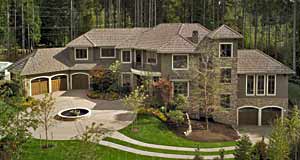Concrete Tiles: Durable, Sustainable Roofing Materials Integrate Design and Performance
Design Considerations
Concrete tiles incorporate many design features for optimal performance. Special tile head lugs are used to engage the battens to which roof tiles are affixed, assuring a seamless fit among components. Weather checks are performed at the nose to reduce water intrusion. Interlocking side laps channel water off the roof and protect the underlayment.
An elevated batten system allows unrestricted water runoff that may occur due to condensation, broken tiles, or an unusually severe weather event, such as high winds or heavy rains. The batten system also promotes increased airflow under the tile and reduced penetration into the underlayment. Flashing maintains water flow on top of the tile, while containing and maintaining unrestricted water flow under the tile. Eave closures support the eave course in proper plane to the field tile. Weep holes are drilled to supplement proper drainage, and vents promote increased airflow.
In coastal areas with more severe weather, standard flashings are upgraded in strength with self-adhered or multi-ply underlayment, along with a two-component adhesive that expands to establish contact with both the underlayment and the bottom of the roof tile.
Structural Issues
Although concrete tile weighs two to three times as much as asphalt and fiberglass shingles, and about twice as much as wood shakes, most roofs are designed to allow for two layers of asphalt shingles, which is not necessary with concrete tile. As a result, depending on the project conditions, additional structural engineering to compensate for the weight of the roofing material may be minimal.
|
Basic design principles allow aesthetic and structural advantages of concrete tile and maximize efficiency. A wood frame load path for receiving concrete roof tile is built with a foundation, sill plate, stud wall, headers, a top plate, ceiling joists, and rafters. For a rafter span chart, the maximum weight a rafter span can withstand, possible required adjustments include purlins (horizontal members fastened perpendicularly to the underside of a rafter and braced to the bearing wall) and ties, all as part of system joining relevant components. Rafter span charts deal only with gravity loads and the support capabilities of the rafters to control deflection. When measured spans exceed the chart criteria, additional bracing is required.
After the rafters have been reinforced to prevent deflection of the load, attention must be shifted to the design aspect of load transfer. The easiest way to understand this concept is to picture a simple triangle and realize that the top two diagonal chords are the rafters holding the weight of the roof and the bottom point is the tie that keeps them from spreading apart. Ties can be standard ceiling joists or T-ties when ceiling joists are not possible. Ultimately, concrete roof tile can be installed on virtually any roof configuration.
Although concrete tiles can be made to work on steep roof slopes, more moderate roof slopes can achieve the same design effect while saving both construction materials and installation costs. For example, a 12:12 roof slope (or 45 degrees) compared to a 9:12 (75 degrees) roof slope achieves the same architectural intent, while saving approximately 15 percent in materials and 20 percent in installation costs. Proportionate savings would accompany lower roof slopes.
Excessive use of multiple hips, valleys and offset eaves are effective when using roofing materials with limited depth and dimension. But they are not as necessary when using concrete roof tile. Cut-up roofs, those which are of unique shapes differing from standard rectangular forms, are more expensive because they require more cuts on field tiles and trim at transition points where a portion of tile ends, such as the edge or the top of a pitched room. Trim tile along the edges of these transition points is also more expensive to install than standard field tile.
Larger roof sections increase roofer efficiency. Designing roof sections to accommodate even tile coursing reduces cutting and lowers installation costs without compromising desired architectural elements.










